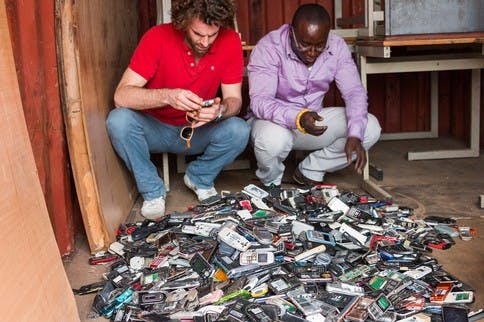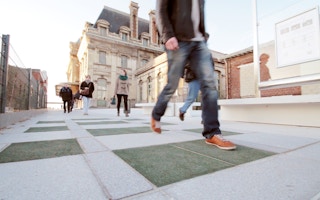Mobile technology is the most promising way to bring about improvements to the way people worldwide live, according to recent findings by the Nominet Trust, a UK-based organisation that invests in projects which use technology to tackle pressing social challenges.
The trust also found that while the power of the internet, mobile phones, data processing and computers to achieve social change has long been acknowledged, a lack of funding, innovation and public awareness about the social enterprise technology sector are holding back the work of technology entrepreneurs in this industry.
In a bid to address these shortcomings, the Nominet Trust last month issued an open call for nominations for the 2014 round of its Nominet Trust 100 (NT100) initiative, an annual effort to profile 100 noteworthy digital projects that are tackling pressing social issues. While no funding is awarded to projects featured in the NT100, the curated list aims to celebrate existing efforts by social innovators and inspire others to follow in their footsteps to tackle global challenges.
Now in its second year, the NT100 list is curated by an international panel of experts including innovation strategist Charles Leadbeater, media experts, educators, and leaders of technology enterprises such as the social innovation platform OpenIDEO.
NT100 projects work towards achieving a broad range of outcomes, including environmental sustainability, economic and civic empowerment, health, and education.
The inaugural NT100 list, published in 2013, identified several projects worldwide which helped to achieve sustainable development by improving energy efficiency, reducing the consumption of natural resources, and enhancing food and water security. Eco-Business profiles five projects with the most potential to spur global green growth:
1. Fairphone

The Fairphone is designed to be recyclable, thus minimising e-waste. Image: Fairphone
The increasing potential of mobile technology to achieve social good is tempered by the fact that the precious metals that are used in every phone – such as tungsten, copper, gold, silver, and tin – are sourced from mines in conflict-ridden areas such as the Congo. They are often extracted under unsafe conditions and unethical labour practices; revenues from this mining can also be used to fund further conflict.
The Fairphone, an Anglo-Dutch venture, aims to reduce the social and environmental impact of mobile phones by ensuring that the minerals used to manufacture the device are responsibly mined, and fund economic development rather than conflict. The phone’s designers also aim to extend the phone’s lifespan by releasing the phone’s design blueprint publicly and making it possible to repair individual components.
About 60,000 Fairphones have been manufactured to date. The steering committee of the NT100 noted that despite the niche market for the Fairphone, “it is incredibly valuable, with great potential to influence bigger players in the field.”
2. Sarvajal
In the same way that automated teller machines (ATMs) dispense money, the Sarvajal initiative aims to provide clean water to marginalised communities in India’s rural areas, slums, low-income schools and hospitals through water ATMs, or AWMs.

Villagers in India access a Sarvajal “AWM”. Image: Sarvajal
These energy efficient machines combine sophisticated hardware and software to dispense potable water to communities around the clock for as little as US$3 per household per month. The initiative also fosters local entrepreneurship through a franchise model where individuals can profit from operating and maintaining AWMs.
Sarvajal has delivered more than 8.8 billion litres of clean drinking water to its target communities to date. The NT100 2013 steering committee praised the initiative’s “eloquent use of technology to underwrite a social business model that meets one of our most basic human needs.”
3. Digital Green
Digital Green promotes sustainable agriculture across South Asia and Sub-Saharan Africa by using videos and internet sharing to develop community-led solutions to threats to rural livelihoods, such as climate change and poverty.
Local volunteers identify farmers whose practices have helped them achieve higher crop yields and create short videos documenting these strategies. The videos are then screened on battery-operated projectors to farmers from the entire village. These discussions are facilitated by community mediators. Through these sessions, participants are able to develop practices that increase community resilience in a locally focused and cost-effective way.
Furthermore, the process of producing and sharing these videos is powered by a data management framework designed to allow people to upload videos despite irregular internet connectivity.
Digital Green has produced 2,800 videos in 20 languages so far, which are publicly available on the project website. It has reached 330,000 farmers across India and Africa, and plans to raise this figure to 1 million by 2015.
4. Pavegen
Pavegen, an initiative that makes tiles which are fitted with technology that converts the kinetic energy of footsteps to electricity, was seen as a “particularly intelligent” effort by the NT100 steering committee.

Participants at Singapore’s Earth Hour 2013 celebrations party on a dancefloor paved with Pavegen tiles. Image: Pavegen
The energy harvested by the tiles can power nearby pedestrian lighting or advertising signage, or also be stored in a battery. Pavegen tiles have already been incorporated into the urban infrastructure of cities such as London, New York and Saint Omer in France. The tiles also made an appearance in Singapore during Earth Hour 2013, where they were used to tile a dance floor. As event-goers danced, the kinetic energy of their footsteps was used to power an on-site screening of a film about the campaign.
Not only does this technology serve as a way to generate renewable energy, the tiles are also able to help make urban planning more effective by collecting and transmitting data about human movements in the city. The surface of Pavegen tiles are made from 100 per cent recycled rubber and the tiles are also designed to be extremely durable.
5. Mosaic
Dubbed the first “peer to peer lending platform for solar power,” American initiative Mosaic aims to dispel the perception that adopting solar energy is an expensive undertaking by providing a platform for individuals to invest in solar installation projects for as little as $25.
Through Mosaic, individuals fund solar installations on homes, offices, and schools across America. The panels that are installed through these investments generate electricity, which is sold to yield returns for investors. Some investments are offered on a zero interest basis, while others can earn returns of 5 per cent or more for investors.
The NT100 curating committee called Mosaic a “simple but well-executed mechanism,” adding that it would change the nature of the relationship between consumers and producers of energy.
Technology for a more sustainable Asia
Annika Small, Nominet Trust chief executive, said that these sustainable digital innovations had significant potential to help achieve sustainable growth in rapidly developing Asia.
She noted that the results of rapid urban and economic growth – such as the proliferation of coal-powered fire stations, or disorganised urban planning that did not adhere to “smart city” principles - could overwhelm any environmental considerations.
“Social tech ventures featured on the 2013 Nominet Trust 100 can raise awareness of such issues; projects like Mosaic and Pavegen are directly involved in urban development too. Furthermore, Sarvajal and Digital Green can support the ongoing viability of rural communities,” she said.
“The NT100 continues to seek out new exciting ventures, and are encouraging the public to share what inspires them through the open nominations for this year’s NT100,” she added.

















